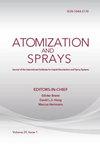从含有可溶性表面活性剂和乳化油的水片状液体中喷射液滴大小
IF 0.9
4区 工程技术
Q4 ENGINEERING, CHEMICAL
引用次数: 0
摘要
由喷嘴产生的液体片雾化产生的农业喷雾产生的液滴大小范围很大,这影响了作物覆盖和喷雾漂移。虽然操作条件和喷嘴类型是实现最佳液滴尺寸的主要因素,但喷射混合物的化学成分对液滴尺寸分布也有实质性影响。特别是,在农业佐剂中发现的表面活性剂和乳化油滴的存在会影响液滴的大小,其中表面活性剂倾向于减小液滴的大小,而乳化油滴倾向于增大液滴的大小。然而,对表面活性剂和乳化油滴耦合的机理层面的理解仍然是未知的。在这项研究中,模拟了水、乳化矿物油和表面活性剂TritonX-100(水溶性)和Span 80(油溶性)在不同浓度下的喷雾系统,并在低速风洞中通过扁平风扇喷嘴喷射。采用激光衍射装置测量了喷雾液滴的尺寸分布随表面活性剂和油的组成的变化。结果表明,表面活性剂的浓度对喷雾液滴的粒径具有非单调的依赖性,重要的是,喷雾液滴的粒径与油乳粒径、水相动态表面张力和表面活性剂的临界胶束浓度都有关系。结果还表明,油相表面活性剂对喷射液滴尺寸没有显著影响。虽然受到农业工业的推动,但表面活性剂和油乳剂在喷雾液滴尺寸上的协同作用的新见解在多相印刷、涂料和油漆方面具有更广泛的应用潜力。本文章由计算机程序翻译,如有差异,请以英文原文为准。
Spray droplet sizes from aqueous liquid sheets containing soluble surfactants and emulsified oils
Agricultural sprays produced from the atomization of a nozzle-generated liquid sheet produce a wide range of droplet sizes, which impacts crop coverage and spray drift. While the operating conditions and nozzle type are main factors to achieve optimal droplet sizes, the chemical composition of the sprayed mixture also has substantial effect on the droplet size distribution. Particularly, the presence of surfactants and emulsified oil droplets found in agricultural adjuvants can influence droplet sizes, where surfactants tend to decrease droplet sizes and emulsion droplets tend to increase droplet sizes. However, the coupled, mechanistic level understanding of surfactants and emulsified oil droplets together remains mainly unknown. In this study, model spray systems of water, emulsified mineral oil, and surfactants TritonX-100 (water-soluble) and Span 80 (oil-soluble) at varied concentrations are sprayed through a flat-fan nozzle in a low-speed wind tunnel. A laser diffraction setup is used to measure the size distribution of spray droplets as a function of surfactant and oil compositions. The results show a non-monotonic size dependence on surfactant concentration, and importantly that the sprayed droplet sizes are linked with both the oil emulsion size and the aqueous phase dynamic surface tension and surfactant’s critical micelle concentration. The results also show that the oil phase surfactant has no significant impact on the sprayed droplet sizes. While motivated by the agricultural industry, the new insight into surfactant and oil emulsion synergism on sprayed droplet sizes has potential broader applications in multiphase printing, coating, and painting.
求助全文
通过发布文献求助,成功后即可免费获取论文全文。
去求助
来源期刊

Atomization and Sprays
工程技术-材料科学:综合
CiteScore
2.10
自引率
16.70%
发文量
54
审稿时长
1.7 months
期刊介绍:
The application and utilization of sprays is not new, and in modern society, it is extensive enough that almost every industry and household uses some form of sprays. What is new is an increasing scientific interest in atomization - the need to understand the physical structure of liquids under conditions of higher shear rates and interaction with gaseous flow. This need is being met with the publication of Atomization and Sprays, an authoritative, international journal presenting high quality research, applications, and review papers.
 求助内容:
求助内容: 应助结果提醒方式:
应助结果提醒方式:


